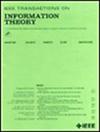计算生物学中的痕迹重建问题。
IF 2.2
3区 计算机科学
Q3 COMPUTER SCIENCE, INFORMATION SYSTEMS
引用次数: 20
摘要
Vladimir Levenstein在20年前提出了从易出错的副本重建字符串的问题,即痕迹重建问题。虽然在痕迹重建方面已经有了相当多的理论工作,但在免疫基因组学和DNA数据存储这两个快速发展的研究领域,实用的解决方案直到最近才开始出现。在免疫基因组学中,痕迹对应于基因的突变拷贝,突变是由适应性免疫系统自然产生的。在DNA数据存储中,痕迹对应于编码数字数据的DNA分子的嘈杂副本,错误是数据检索过程中的伪影。在本文中,我们介绍了几种新的痕量生成模型和与免疫基因组学和DNA数据存储的痕量重建相关的悬而未决的问题,综述了痕量重建的理论结果,并强调了它们与计算生物学的联系。在整个过程中,我们讨论了已知解决方案的适用性和缺点,并提出了未来的研究方向。本文章由计算机程序翻译,如有差异,请以英文原文为准。
Trace Reconstruction Problems in Computational Biology
The problem of reconstructing a string from its error-prone copies, the trace reconstruction problem, was introduced by Vladimir Levenshtein two decades ago. While there has been considerable theoretical work on trace reconstruction, practical solutions have only recently started to emerge in the context of two rapidly developing research areas: immunogenomics and DNA data storage. In immunogenomics, traces correspond to mutated copies of genes, with mutations generated naturally by the adaptive immune system. In DNA data storage, traces correspond to noisy copies of DNA molecules that encode digital data, with errors being artifacts of the data retrieval process. In this paper, we introduce several new trace generation models and open questions relevant to trace reconstruction for immunogenomics and DNA data storage, survey theoretical results on trace reconstruction, and highlight their connections to computational biology. Throughout, we discuss the applicability and shortcomings of known solutions and suggest future research directions.
求助全文
通过发布文献求助,成功后即可免费获取论文全文。
去求助
来源期刊

IEEE Transactions on Information Theory
工程技术-工程:电子与电气
CiteScore
5.70
自引率
20.00%
发文量
514
审稿时长
12 months
期刊介绍:
The IEEE Transactions on Information Theory is a journal that publishes theoretical and experimental papers concerned with the transmission, processing, and utilization of information. The boundaries of acceptable subject matter are intentionally not sharply delimited. Rather, it is hoped that as the focus of research activity changes, a flexible policy will permit this Transactions to follow suit. Current appropriate topics are best reflected by recent Tables of Contents; they are summarized in the titles of editorial areas that appear on the inside front cover.
 求助内容:
求助内容: 应助结果提醒方式:
应助结果提醒方式:


